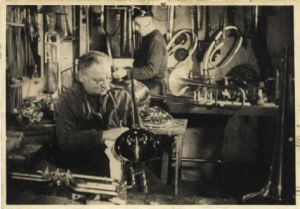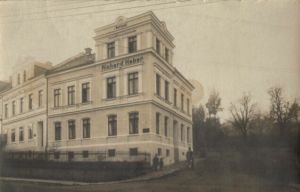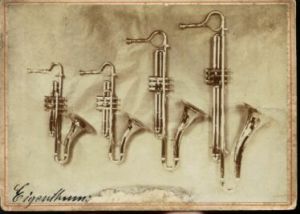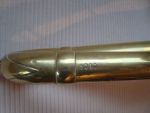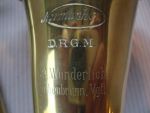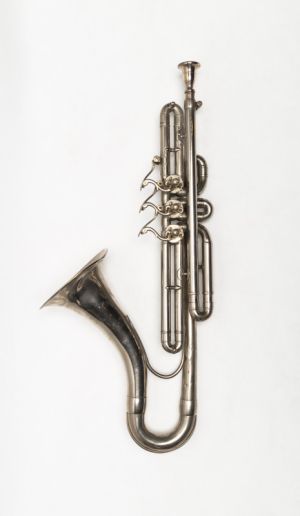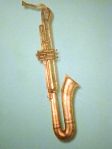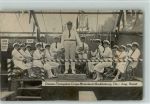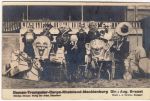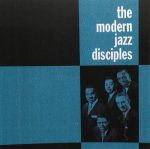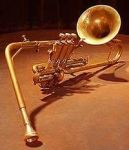Difference between revisions of "Normaphone"
Gwesterhof (talk | contribs) |
Gwesterhof (talk | contribs) m (→Other sax shaped trumpets) |
||
| (61 intermediate revisions by the same user not shown) | |||
| Line 1: | Line 1: | ||
=The Normaphone= | =The Normaphone= | ||
| − | The Normaphon was a saxophone shaped trumpet with | + | The [http://www.normaphon.com/ Normaphon] was a saxophone shaped trumpet with one bell. |
| + | The history of the Normaphone is more or less the same as the history of the two-belled <strong>[[Jazzophone]]</strong>. Where the Jazzophone originated on the Czech side of the border, in Graslitz, the inventor of the Normaphone lived in Markneukirchen at the German side, only a few miles away. | ||
[[File:Richard Oscar Heber1 .jpg|thumb|left|<small>Richard Oskar Heber at work</small>]] | [[File:Richard Oscar Heber1 .jpg|thumb|left|<small>Richard Oskar Heber at work</small>]] | ||
[[File:Schuetzenstrasse 36 Markneukirchen.jpg|thumb|left|<small>Schützenstrasse 36 Markneukirchen photo's copyright Ines Ann Heber</small>]] | [[File:Schuetzenstrasse 36 Markneukirchen.jpg|thumb|left|<small>Schützenstrasse 36 Markneukirchen photo's copyright Ines Ann Heber</small>]] | ||
| + | [[File:Normaphoneinjazzo.jpg|thumb|left|<small>Normaphons, photo copyright by Ines Ann Heber </small>]] | ||
| + | ==Richard Heber== | ||
| + | The Normaphon was invented by Richard Oskar Heber (1872-1938). Between 1900 and 1935 he produced brass instruments under the Norma-brand at the Schützenstrasse 36 in Markneukirchen. Heber advertised the Normaphone as very appropriate for 'Jazz-Band und sonstige Effekt-Kapellen'. Roughly 100 Normaphons were built from approximately 1924/25 until 1930, and were distributed through wholesalers such as C.A. Wunderlich in Siebenbrunn, R.O. Adler, Johannes Adler and C.G Glier in Markneukirchen, Ammon Gläser in Erlbach and M. J. Kalashen in New York. The Gebrüder Schuster in Markneukirchen, 'Fabrik und Export von Musikinstrumenten und Saiten', from 1854, had the Normaphone in their [[Media:Schuster_nr_70_'1925'_-_207_-_Jazzband-Instrumente.jpg|Katalog Nr. 70]], (ca. 1929). Normaphones were sent out to musical directors all over the world to promote the new instrument. | ||
| − | + | Like the Jazzophon the Normaphone also had a D.R.G.M-registration, dates 26.02.1926, number 51c. 945 751, under the name 'Metallblasinstrument', on Richard Hebers name. | |
| − | The | + | The [[Media:Glier1926-57-bg.jpg|C.G.Glier catalog]] from October 1926 states that patents are claimed both at home and abroad. There were four sizes of the instrument (specials possible), but most of them were build in tenor. Albert Rice explains that they were build not only with piston but also with rotary valves. The National Music Museum in Vermillion SD owns the only known rotary valve example. The soprano also had a version with an echo effect-valve, similar to the Jazzophon. Initially, there also was a choice between [[Media:Katalog_Heber_Normaphon.jpg|high and low pitch]]. |
| − | + | Max Adler from Erlbach offered in his [[Media:Max_Adler_Normaphon.JPG|catalogue number 25]] also the English high pitch and the Normaphon in C and in F for the same price. Adler advertises the Normaphon as a solo instrument. | |
| − | + | Remarkable: C.A. Wunderlich offered around 1928 also a soprano version of the Normaphon with an echo effect valve, a kind of Jazzophon in fact. The New Langwill Index states that C.A. Wunderlich held the Normaphon patent, that could be a misinterpretation or Wunderlich must have acquired it from Heber. | |
| − | + | In or after 1931 [[Media:R_O_Adler_Normaphon.JPG|Robert Oswald Adler]] still (and only) offered the sopran, alto and tenor Normaphon, as did [[Media:Johannes Adler preisliste 31 p 113.jpg|Johannes Adler]] in his Liste 31. The 1934 C.A.Wunderlich catalog shows no Normaphons nor Jazzophons anymore. | |
| − | + | Pieter Aafjes, from 1907 - 1947 musical director of Crescendo, a concert band in Culemborg, the Netherlands, obtained an alto Normaphon from C.A. Wunderlich with serial number 0104, to give it a try. Through Riet van Dillen, the daughter of his successor Jac van Dillen, it came in my possession. | |
| − | [[File:NMM 1526 Normaphon 0200 rotary.jpg|thumb| | + | |
| + | <gallery widths="150" heights="150"> | ||
| + | File:Normafoon Riet van Dillen Es (2).JPG | ||
| + | File:Normafoon Riet van Dillen Es (4).JPG | ||
| + | File:Normafoon Riet van Dillen Es (5).JPG | ||
| + | File:Normafoon Riet van Dillen Es (6).JPG | ||
| + | </gallery> | ||
| + | |||
| + | <small>Alto Normaphon in Eb, originally nickel plated, serial number 0104. On the bell: C.A. Wunderlich Siebenbrunn Vogtl. coll. Gerard Westerhof</small> | ||
| + | [[File:NMM 1526 Normaphon 0200 rotary.jpg|thumb|right|<small>Normaphon with rotary valves, serial number 0200, coll. NMM</small>]] | ||
The [https://www.usd.edu/fine-arts/national-music-museum National Music Museum of the University of South Dakota] has a soprano and two tenor Normaphons, one of them having rotary valves. This last one (serial number 0200), the only example with the usual Normaphon D.R.G.M. Germany engraving with rotary valves known so far, has no distributor name engraved. | The [https://www.usd.edu/fine-arts/national-music-museum National Music Museum of the University of South Dakota] has a soprano and two tenor Normaphons, one of them having rotary valves. This last one (serial number 0200), the only example with the usual Normaphon D.R.G.M. Germany engraving with rotary valves known so far, has no distributor name engraved. | ||
| − | + | The [http://minim.ac.uk/index.php/explore/?instrument=44263 Museum of Army Music] in the UK has a Bb Normaphone with top action rotary valves. It has no makers name and is numbered 4 on the machine. Made of nickel/chrome-plated brass with some solid nickel-silver mechanisms. The top-action rotary valves have mechanical linkages, coiled springs, and cork bumpers. | |
| + | |||
| + | [[File:MIMIM Normaphone 4.jpg|thumb|left|<small>Normaphon with top action rotary valves, serial number 4, coll. MIMIM</small>]] | ||
| + | |||
| + | |||
| + | |||
| + | |||
| + | |||
| + | |||
| + | |||
| + | |||
| + | |||
| + | Other Normaphones can be found amongst others at the [https://www.ed.ac.uk/information-services/library-museum-gallery/crc/collections/musical-instrument-collection/ Edinburgh University Collection of Historic Musical Instruments], the [https://themim.org/ MIM] in Phoenix, the [http://www.mimo-db.eu/MIMO/infodoc/ged/view.aspx?eid=OAI_ULEI_M0004671/ Museum of Musical Instruments] of the Leipzig University, [http://www.hjmbrasscollection.com/ the HJM Brass Collection] in Turku, Finland and the [http://www.trompetenmuseum.de/ Trompetenmuseum] in Bad Säckingen (that has a tenor from Schuster & Co.). | ||
| + | |||
| + | |||
| + | |||
| + | |||
| + | |||
| + | |||
| + | |||
| + | |||
| + | |||
| + | |||
| + | |||
| + | |||
| + | |||
| + | |||
| + | ===Leopold Renz=== | ||
| + | |||
| + | <gallery widths="150" heights="150"> | ||
| + | File:Normaphon Leopold Renz Dullatboek TM Markn.JPG | ||
| + | File:Normaphon Leopold Renz Markneukirchen Museum.jpg | ||
| + | File:Normaphone Leopold Renz Berlin Trompetmuseum Markneukirchen.JPG | ||
| + | </gallery> | ||
| + | <small>Normaphone in Bb, coll. Musikinstrumenten Museum Markneukirchen. Engraved: Leopold Renz, Instrumentenmacher Berlin N 58 Gaudystr.14</small> | ||
| + | |||
| + | Leopold Renz, Instrumentenmacher, Berlin, N58 Gaudystr.14, made this tenor instrument, with a total length of 277 cm. Günter Dullat, who used it for the cover of his book Blasinstrumente names it also a Normaphone and states that the Normaphone (this Normaphon?) in the nineteen twenties was developed by Robert Schopper (1859-1938) in Leipzig. Renz worked as an instrument maker from 1916 onwards, and from 1927 under his own name. According to Dullat, he worked in Graslitz (Kaiserstr. 1051) as a woodwind instrument maker and moved to Berlin around 1936. This instrument is dated 'before 1939'. | ||
| + | |||
| + | ==The Normaphone in action== | ||
| + | ===Damen Kapellen=== | ||
| + | Sofar the only pictures of a Normaphone in an orchestral setting found are those of the Damen Trompeter Korps Rheinland Mecklenburg <small>(thanks to Vaclav Muska).</small> | ||
<gallery widths="150" heights="150"> | <gallery widths="150" heights="150"> | ||
| − | File: | + | File:Damen Trompeter Corps mit Normaphons.jpg|<small>Five members of the Damen Trompeter Korps Rheinland - Mecklenburg with different sizes of Normaphons (2 sopran, 1 alto, 1 tenor, 1 baritone)</small> |
| − | File: | + | File:dtc rheinland.jpg|<small>The full orchestra with Normaphons hanging at the wall in the back right.</small> |
| − | + | File:Damen breest norma.jpg|<small>The same orchestra with a carnavalesque array of props. Some Normaphons in the front right</small> | |
| − | + | </gallery> | |
| − | + | In the German speaking countries of Europe in the 1890s through to World War I there appeared a large number of “Damen Kapellen”, troupes of entertainers: brass/wind ensembles, string “orchestras”, salon “orchestras”, singing, dancing and theatre variety groups. These largely consisted of women, usually led by a man, and occasionally including males as players. These were professional groups and performed in theatres, as part of larger variety and vaudeville programmes, also at various concert venues in town and countryside. | |
| + | |||
| + | The female brass ensembles were generally known as “Damen Blasorchester” or “Damen Trompeterkorps” and consisted of a variety of instrumentalists, almost exclusively brass (though some groups did double up on stringed instruments, drums or handbells - for example). In addition to their instrumental playing they would sometimes also sing and dance and go through various costume changes as part of their performances. Fanfare trumpets were a feature of some ensembles. | ||
| + | |||
| + | The music performed ranged from the popular tunes of the day, military marches, and “salon music” to sophisticated arrangements of classical and operatic works. These were written and transcribed by the members, though perhaps more usually by the male “Director” of the ensemble. (I parafrase 'Damen und Damen - Ladies’ professional travelling brass ensembles of the German Empire 1871-1918 by Gavin Holman, 2017, who borrows a lot from Dorothea Kaumann's 'routinierte Trommlerin gesucht' from 1996.) | ||
| + | |||
| + | Ensembles including brass instruments were particularly popular in some environments – e.g. restaurants and outdoor events – where their music could be heard over the background noise. These brass groups had their origins in the military bands of the early 19th century which included woodwind and brass instruments, the brass being increasingly dominant as the instruments evolved, using piston valves and more efficient manufacturing techniques. | ||
| + | The relatively low cost, ease of learning and playing of the brass instruments, made them eminently suitable for the new women’s ensembles (as also for the village and town bands). Indeed, many of these groups maintained the links to the earlier bands by adopting costumes modelled on military uniforms. Other costumes were based on traditional folklore dress and more normal female attire of the day. | ||
| + | |||
| + | It was not until the 1890s that the numbers of women’s groups increased significantly. Each city had at least one group resident or as part of a touring company, in Dresden alone, there were up to ten Damen Kapellen of various types regularly performing after 1900. They took advantage of the economic prosperity around the turn of the century, the popularity of theatres and vaudeville shows, the demand from large restaurants, bars and exhibitions for entertainers, and the easing of the labour market for women. Their engagements generally lasted from two weeks to several months, depending on the venue and tour commitments of the ensembles, moving on to the next town for their new contract, even beyond the traditional German speaking countries. | ||
| − | + | An analysis by Dorothea Kaufmann from adverts in “Der Artist” (a German version of “The Stage” or “Variety”) shows an increase in the numbers of Damen Kapellen from 43 in 1894, peaking at 299 in 1913, then declining sharply in the early 1920s, running around 30 or so until WW2. The groups averaged seven to eight females and up to two or three males. After WW1 the groups tended to reduce in numbers to three/four female and perhaps one male on average. | |
| − | + | ===Karl Linsenmeijer=== | |
In 1956 Karl Linsenmeijer, then 16 years old, entered the [http://www.musikverein-offnadingen.de/wp-content/uploads/2017/09/OMZ-13-2015.pdf Musikverein Offnadingen] (a small village near Freiburg, Germany) and played an alto Normaphon untill he changed to clarinet in 1965. He played it together with Karl Schleer, who changed to flugelhorn. The Musikverein had severe losses during WWII, having only 5 active members left in 1945. The Normaphon was bought because at the time the money was very tight and sometimes even two musicians had only one instrument, so Jürgen Schleer, now chairman and son of Karl. Where it was bought is not known, after 1965 it went to a music store. In the orchestra the Normaphon was counted as a flugelhorn, the notes were always rewritten by the conductor, mostly from the tenor horn. "The exotic Normaphon has always been a highlight and an eye-catcher at every party and every performance', says Jürgen. | In 1956 Karl Linsenmeijer, then 16 years old, entered the [http://www.musikverein-offnadingen.de/wp-content/uploads/2017/09/OMZ-13-2015.pdf Musikverein Offnadingen] (a small village near Freiburg, Germany) and played an alto Normaphon untill he changed to clarinet in 1965. He played it together with Karl Schleer, who changed to flugelhorn. The Musikverein had severe losses during WWII, having only 5 active members left in 1945. The Normaphon was bought because at the time the money was very tight and sometimes even two musicians had only one instrument, so Jürgen Schleer, now chairman and son of Karl. Where it was bought is not known, after 1965 it went to a music store. In the orchestra the Normaphon was counted as a flugelhorn, the notes were always rewritten by the conductor, mostly from the tenor horn. "The exotic Normaphon has always been a highlight and an eye-catcher at every party and every performance', says Jürgen. | ||
| − | In 1957 Nat King Cole performed 'Rosetta' in one of his shows together with Billy Eckstine (8 July 1914 – 8 March 1993), Eckstine playing a tenor Normaphone (from 2.12"). | + | ===Nat King Cole=== |
| + | In 1957 Nat King Cole performed 'Rosetta' in one of his shows together with Billy Eckstine (8 July 1914 – 8 March 1993), [https://www.youtube.com/watch?v=_Ce6iGIX1Cg/ Eckstine playing a tenor Normaphone] (from 2.12"). | ||
| + | ===William 'Hicky' Kelley=== | ||
| + | William 'Hicky' Kelley played a Normaphone (probably an alto) in 1959 and 1960 with the Modern Jazz Disciples on two records, 'The modern jazz disciples' and 'right down front'. Kelley (March 12, 1929 Cincinnati - May 9, 1998 Cincinnati) started his musical career on the trumpet and later picked up the Normaphone. The notes to the original first album of the Modern Jazz Disciples state that Kelley would like it made clear that that his use of the Normaphon (and the euphonium on one track) is "not one of novelty. He is dedicated to their use as jazz pieces. He has no desire to become an 'avant-courier' for them in the field of jazz." [https://www.youtube.com/watch?v=mAbJ-lKw77U Here]'s Kelley on the Normaphone in [https://www.youtube.com/watch?v=mAbJ-lKw77U/ Disciples Blues] (as of 4.50") (and [http://www.milofultzmusic.com/blog/2015/1/18/lead-sheet-of-disciples-blues here]'s more about this piece). | ||
<gallery widths="150" heights="150"> | <gallery widths="150" heights="150"> | ||
File:William Kelley.jpg|<small>William 'Hicky' Kelley</small> | File:William Kelley.jpg|<small>William 'Hicky' Kelley</small> | ||
| Line 43: | Line 108: | ||
</gallery> | </gallery> | ||
| − | + | ===Scott Robinson=== | |
| + | Multi instrumentalist Scott Robinson from Teaneck, New Jersey, played a tenor Normaphon on his first LP [[Media:MultipleInstruments_Scott_Robinson.gif|Multiple Instruments]] from 1984 and in later years with Hazmat Modine on their CD Bahamut. | ||
| + | Here's a youtube of Scott [https://youtu.be/4LAkLc-qUvE playing the Normaphone], August 13nd 2023. | ||
| + | |||
| + | ===Tom Guralnick=== | ||
| + | Tom Guralnick has a tenor Normaphon (serial number 0238) that he got from Bob Klein in New York around 2001. Bob's father played in the NY Philharmonic and taught in a community music school where he discovered it some 50 years ago when he closed down the music school, and Bob gave it to Tom some 15 years ago. Tom is the director at Outpost, Albuquerque, and occasionally shows the instrument to guest musicians. 'Rosewell Rudd dug it". Here's jazz trumpeter Bobby Bradford (1934) trying, with Tom looking. | ||
| + | |||
| + | <gallery widths="150" heights="150"> | ||
| + | File:Bobby Bradford with Tom Guralnick looking, 12 april 2004 Outpost Albuquerque.jpg|thumb|left|<small>Bobby Bradford and Tom Guralnick 12 april 2004, photo Mark Weber</small> | ||
| + | </gallery> | ||
| + | |||
| + | ===Bob Zajíček=== | ||
| + | Legendary Prague trumpeter and cornettist Luboš 'Bob Zajíček (6-10-1938) and his quintet performed on December 18th, 2013 at ...., with Bob (center) on a soprano Normaphone, ... on Violinophone and .. on a Jazzophone, probably pitched in Eb. Bob Zajíček also hosts a programm called [https://vltava.rozhlas.cz/jazzofon-5057400 JAZZOFON] on radio station Vltava. Zajíček and his friends, playing what's now called traditional jazz, are keeping alive a tradition of which the Jazzophon is the ultimate icon. | ||
| + | |||
| + | <gallery widths="150" heights="150"> | ||
| + | File:2013 12 18 Happy New Year Bob Zajicek 1.jpg|<small>Bob Zajíček Kvintet</small> | ||
| + | </gallery> | ||
| + | <gallery widths="150" heights="150"> File:Jazzofon coll Bob Zajicek.jpg|<small>Soprano Normaphon coll. B.Zajíček</small> | ||
| + | </gallery> | ||
| + | |||
| + | ==Normaphons overview== | ||
| − | + | Here's an overview of the Normaphones I detected so far. Please let me know when you know of others. Serial numbers range from 0104 till 0441, suggesting that there might have been a few hundred of them. I didn't manage to find another Heber instrument with a serial number yet, to see if he used these numbers for all his instruments or for the Normaphones exclusively. | |
| − | + | <gallery widths="150" heights="150"> | |
| + | File:1.jpg|1 | ||
| + | File:2.jpg|2 | ||
| + | File:Normaaa 3.jpg|3 | ||
| + | File:Norma 4.jpg|4 | ||
| + | Normaphon_C.A._Wunderlich_tenor_Museum_Basel.jpg|5 | ||
| + | File:Norma6.jpg|6 | ||
| + | File:Nmm 1525. Tenor Normaphon by Heber Workshop, Markneukirchen, Germany, ca. 1930..jpg|7 | ||
| + | File:Normaphon 0104.jpg|0104 | ||
| + | File:Normaphon 0109 yogyakarta.jpg|0109 | ||
| + | File:0117 jpg.jpg|0117 | ||
| + | File:Normaphons Scott Robinson 1 150.jpg|150 | ||
| + | File:Normaphon 0187 10,11,12 (1).jpg|0187 | ||
| + | File:Normaphon 0196 Wunderlich Leipzig.jpg|0196 | ||
| + | File:NMM 1526 Normaphon 0200 rotary.jpg|200 | ||
| + | File:Normaphone Tom Guralnick 0238.jpg|238 | ||
| + | File:Normaphon 0240 (5).jpg|240 | ||
| + | File:Normaphon 0267.jpg|267 | ||
| + | File:Normaphon 0306 tenor (3).jpg|306 | ||
| + | File:0315.jpg|0315 | ||
| + | File:0344.jpg|0344 | ||
| + | File:Normaphon 0346.jpg|346 | ||
| + | File:Normaphons Scott Robinson 350 tenor.jpg|350 | ||
| + | File:Normaphon 362 tenor feb 2018.jpg|362 | ||
| + | File:Normaphon 0390 sopraan 0.jpg|390 | ||
| + | File:0441.jpg|0441 | ||
| − | + | </gallery> | |
| + | |||
| + | <small> | ||
| + | 1. tenor Normaphon D.R.G.M. coll. MIM, Phoenix US, (until 2011 Fiske Museum, Claremont, US) (Albert Rice speaks of an alto, D.R.G.M./GERMANY"—sold by C.A. Wunderlich) | ||
| + | |||
| + | 2. tenor Normaphon, D.R.G.M. Germany, restauration with new mouthpipe in 2012 by Robb Stewart, coll. Rick Schwartz, Virginia US | ||
| + | |||
| + | 3. soprano Normaphon D.R.G.M. Germany sold in 1998 through Butterfield & Butterfield (maybe same as 0117) alto | ||
| + | |||
| + | 4. tenor Normaphon, D.R.G.M. C.A.Wunderlich Siebenbrunn, Vgtl, offered from Sintra, Portugal through Olx.pt 2016 | ||
| + | |||
| + | 5 tenor Normaphon C.A.Wunderlich Siebenbrunn, Vgtl, coll. Musik-Museum Basel | ||
| + | |||
| + | 6 bell of a sopran Normaphon D.R.G.M. diameter 11 cm, sold through Ebay.de in 2017 | ||
| + | |||
| + | 7 tenor Normaphon coll. NMM, Vermillion South Dakota VS, gekocht in 1977, on permanent display at the Meredith Willson Museum in Mason City, Iowa | ||
| + | |||
| + | nr 0104 alto Normaphon D.R.G.M. C.A.Wunderlich Siebenbrunn Vgtl. valve casings stamped 28,29,30 coll. Gerard Westerhof, Netherlands | ||
| + | |||
| + | nr 0109 tenor Normaphon D.R.G.M Trade Mark/Fabrik Marke coll. Gigion Erino @ern_brass Yogyakarta Indonesia | ||
| + | |||
| + | nr 0117 soprano Normaphon D.R.G.M. Germany valve casings and caps stamped 10, 11 and 12. coll. NMM 7350 Joe R. and Joella F. Utley Collection, 1999 Vermillion South Dakota US US | ||
| + | |||
| + | nr 150 alto Normaphon, coll. Scott Robinson, Teaneck New Jersey, US | ||
| + | |||
| + | nr 0164 tenor Normaphon coll. Eric Budd, Melbourne Australia | ||
| + | |||
| + | nr 0187 tenor Normaphon D.R.G.M. D.R. Patent Germany valve casings stamped 10,11,12, offered on Ebay 2017 | ||
| + | |||
| + | nr 0196 tenor Normaphon D.R.G.M. C.A.Wunderlich Siebenbrunn Vgtl. coll. Museum für Musikinstrumente der Universität Leipzig | ||
| + | |||
| + | nr 0200 tenor Normaphon D.R.G.M. Germany rotary valves coll. NMM 1526, Vermillion South Dakota US | ||
| + | |||
| + | nr 0238 tenor Normaphon coll. Tom Guralnick Albuquerque US | ||
| + | |||
| + | nr 0240 soprano Normaphon D.R.G.M. D.R. Patent, valve casings stamped 1,2,3, for sale on Ebay.be 2018 | ||
| + | |||
| + | nr 0260 tenor Normaphon D.R.G.M. Germany 8188/M. J. KALASHEN/NEW YORK, valves and valve caps stamped: 16, 17, 18, coll. NMM 1525, Vermillion South Dakota US, acquired in 1977, on display at Meredith Willson Museum, Mason City, Iowa US | ||
| + | |||
| + | nr 0267 tenor Normaphon D.R.G.M. Germany 39819 sold through Ebay 2015 | ||
| − | + | nr 0306 tenor Normaphon D.R.G.M. C.A.Wunderlich Siebenbrunn Vgtl. sold through Ebay.de 2014 | |
| − | + | nr 0315 tenor Normaphon D.R.G.M. valves numbered 4,5,6 coll. Edinburgh University, UK | |
| − | + | nr 0344 alto Normaphon, D.R.G.M. acquired in 2010, coll. Han Savelkoel, Netherlands | |
| + | nr 0346 tenor Normaphon, D.R.G.M. for sale 2023 Berlin, Germany | ||
| − | + | nr 350 tenor Normaphon, coll. Scott Robinson, Teaneck New Jersey, US | |
| + | nr 362 tenor Normaphon, D.R.G.M, sold through Auktionshaus Mehlis 2018 | ||
| + | nr 0390 soprano Normaphon D.R.G.M. valve numbers 1,2,3 acquired in 2017 by Dirk Arzig GE | ||
| − | + | nr 0441 alto Normaphon coll. Heikki Moisio Turku, Finland | |
| + | </small> | ||
| − | + | ==Other sax shaped trumpets== | |
| − | + | Somehow it seems to be attractive to make trumpets that have the form of a saxophone. The <strong>[[Jazzophone]]</strong> and the <strong>[[Normaphone]]</strong> are presumably the first ones, dating from the jazz crazy twenties of the last century. But there are more examples, some produced inserie, others built as project horns. | |
| + | More at the brasspedia page about <strong>[[Other sax shaped trumpets]]</strong> | ||
| − | + | ==Other sax shaped instruments== | |
| − | + | Then there are other sax shaped instruments that are not trumpets. You can find them on the <strong>[[Brasspedia]]</strong> page about <strong>[[Other sax shaped instruments]]</strong>. | |
Latest revision as of 22:46, 1 January 2024
Contents
The Normaphone
The Normaphon was a saxophone shaped trumpet with one bell. The history of the Normaphone is more or less the same as the history of the two-belled Jazzophone. Where the Jazzophone originated on the Czech side of the border, in Graslitz, the inventor of the Normaphone lived in Markneukirchen at the German side, only a few miles away.
Richard Heber
The Normaphon was invented by Richard Oskar Heber (1872-1938). Between 1900 and 1935 he produced brass instruments under the Norma-brand at the Schützenstrasse 36 in Markneukirchen. Heber advertised the Normaphone as very appropriate for 'Jazz-Band und sonstige Effekt-Kapellen'. Roughly 100 Normaphons were built from approximately 1924/25 until 1930, and were distributed through wholesalers such as C.A. Wunderlich in Siebenbrunn, R.O. Adler, Johannes Adler and C.G Glier in Markneukirchen, Ammon Gläser in Erlbach and M. J. Kalashen in New York. The Gebrüder Schuster in Markneukirchen, 'Fabrik und Export von Musikinstrumenten und Saiten', from 1854, had the Normaphone in their Katalog Nr. 70, (ca. 1929). Normaphones were sent out to musical directors all over the world to promote the new instrument.
Like the Jazzophon the Normaphone also had a D.R.G.M-registration, dates 26.02.1926, number 51c. 945 751, under the name 'Metallblasinstrument', on Richard Hebers name.
The C.G.Glier catalog from October 1926 states that patents are claimed both at home and abroad. There were four sizes of the instrument (specials possible), but most of them were build in tenor. Albert Rice explains that they were build not only with piston but also with rotary valves. The National Music Museum in Vermillion SD owns the only known rotary valve example. The soprano also had a version with an echo effect-valve, similar to the Jazzophon. Initially, there also was a choice between high and low pitch.
Max Adler from Erlbach offered in his catalogue number 25 also the English high pitch and the Normaphon in C and in F for the same price. Adler advertises the Normaphon as a solo instrument.
Remarkable: C.A. Wunderlich offered around 1928 also a soprano version of the Normaphon with an echo effect valve, a kind of Jazzophon in fact. The New Langwill Index states that C.A. Wunderlich held the Normaphon patent, that could be a misinterpretation or Wunderlich must have acquired it from Heber.
In or after 1931 Robert Oswald Adler still (and only) offered the sopran, alto and tenor Normaphon, as did Johannes Adler in his Liste 31. The 1934 C.A.Wunderlich catalog shows no Normaphons nor Jazzophons anymore.
Pieter Aafjes, from 1907 - 1947 musical director of Crescendo, a concert band in Culemborg, the Netherlands, obtained an alto Normaphon from C.A. Wunderlich with serial number 0104, to give it a try. Through Riet van Dillen, the daughter of his successor Jac van Dillen, it came in my possession.
Alto Normaphon in Eb, originally nickel plated, serial number 0104. On the bell: C.A. Wunderlich Siebenbrunn Vogtl. coll. Gerard Westerhof
The National Music Museum of the University of South Dakota has a soprano and two tenor Normaphons, one of them having rotary valves. This last one (serial number 0200), the only example with the usual Normaphon D.R.G.M. Germany engraving with rotary valves known so far, has no distributor name engraved.
The Museum of Army Music in the UK has a Bb Normaphone with top action rotary valves. It has no makers name and is numbered 4 on the machine. Made of nickel/chrome-plated brass with some solid nickel-silver mechanisms. The top-action rotary valves have mechanical linkages, coiled springs, and cork bumpers.
Other Normaphones can be found amongst others at the Edinburgh University Collection of Historic Musical Instruments, the MIM in Phoenix, the Museum of Musical Instruments of the Leipzig University, the HJM Brass Collection in Turku, Finland and the Trompetenmuseum in Bad Säckingen (that has a tenor from Schuster & Co.).
Leopold Renz
Normaphone in Bb, coll. Musikinstrumenten Museum Markneukirchen. Engraved: Leopold Renz, Instrumentenmacher Berlin N 58 Gaudystr.14
Leopold Renz, Instrumentenmacher, Berlin, N58 Gaudystr.14, made this tenor instrument, with a total length of 277 cm. Günter Dullat, who used it for the cover of his book Blasinstrumente names it also a Normaphone and states that the Normaphone (this Normaphon?) in the nineteen twenties was developed by Robert Schopper (1859-1938) in Leipzig. Renz worked as an instrument maker from 1916 onwards, and from 1927 under his own name. According to Dullat, he worked in Graslitz (Kaiserstr. 1051) as a woodwind instrument maker and moved to Berlin around 1936. This instrument is dated 'before 1939'.
The Normaphone in action
Damen Kapellen
Sofar the only pictures of a Normaphone in an orchestral setting found are those of the Damen Trompeter Korps Rheinland Mecklenburg (thanks to Vaclav Muska).
In the German speaking countries of Europe in the 1890s through to World War I there appeared a large number of “Damen Kapellen”, troupes of entertainers: brass/wind ensembles, string “orchestras”, salon “orchestras”, singing, dancing and theatre variety groups. These largely consisted of women, usually led by a man, and occasionally including males as players. These were professional groups and performed in theatres, as part of larger variety and vaudeville programmes, also at various concert venues in town and countryside.
The female brass ensembles were generally known as “Damen Blasorchester” or “Damen Trompeterkorps” and consisted of a variety of instrumentalists, almost exclusively brass (though some groups did double up on stringed instruments, drums or handbells - for example). In addition to their instrumental playing they would sometimes also sing and dance and go through various costume changes as part of their performances. Fanfare trumpets were a feature of some ensembles.
The music performed ranged from the popular tunes of the day, military marches, and “salon music” to sophisticated arrangements of classical and operatic works. These were written and transcribed by the members, though perhaps more usually by the male “Director” of the ensemble. (I parafrase 'Damen und Damen - Ladies’ professional travelling brass ensembles of the German Empire 1871-1918 by Gavin Holman, 2017, who borrows a lot from Dorothea Kaumann's 'routinierte Trommlerin gesucht' from 1996.)
Ensembles including brass instruments were particularly popular in some environments – e.g. restaurants and outdoor events – where their music could be heard over the background noise. These brass groups had their origins in the military bands of the early 19th century which included woodwind and brass instruments, the brass being increasingly dominant as the instruments evolved, using piston valves and more efficient manufacturing techniques. The relatively low cost, ease of learning and playing of the brass instruments, made them eminently suitable for the new women’s ensembles (as also for the village and town bands). Indeed, many of these groups maintained the links to the earlier bands by adopting costumes modelled on military uniforms. Other costumes were based on traditional folklore dress and more normal female attire of the day.
It was not until the 1890s that the numbers of women’s groups increased significantly. Each city had at least one group resident or as part of a touring company, in Dresden alone, there were up to ten Damen Kapellen of various types regularly performing after 1900. They took advantage of the economic prosperity around the turn of the century, the popularity of theatres and vaudeville shows, the demand from large restaurants, bars and exhibitions for entertainers, and the easing of the labour market for women. Their engagements generally lasted from two weeks to several months, depending on the venue and tour commitments of the ensembles, moving on to the next town for their new contract, even beyond the traditional German speaking countries.
An analysis by Dorothea Kaufmann from adverts in “Der Artist” (a German version of “The Stage” or “Variety”) shows an increase in the numbers of Damen Kapellen from 43 in 1894, peaking at 299 in 1913, then declining sharply in the early 1920s, running around 30 or so until WW2. The groups averaged seven to eight females and up to two or three males. After WW1 the groups tended to reduce in numbers to three/four female and perhaps one male on average.
Karl Linsenmeijer
In 1956 Karl Linsenmeijer, then 16 years old, entered the Musikverein Offnadingen (a small village near Freiburg, Germany) and played an alto Normaphon untill he changed to clarinet in 1965. He played it together with Karl Schleer, who changed to flugelhorn. The Musikverein had severe losses during WWII, having only 5 active members left in 1945. The Normaphon was bought because at the time the money was very tight and sometimes even two musicians had only one instrument, so Jürgen Schleer, now chairman and son of Karl. Where it was bought is not known, after 1965 it went to a music store. In the orchestra the Normaphon was counted as a flugelhorn, the notes were always rewritten by the conductor, mostly from the tenor horn. "The exotic Normaphon has always been a highlight and an eye-catcher at every party and every performance', says Jürgen.
Nat King Cole
In 1957 Nat King Cole performed 'Rosetta' in one of his shows together with Billy Eckstine (8 July 1914 – 8 March 1993), Eckstine playing a tenor Normaphone (from 2.12").
William 'Hicky' Kelley
William 'Hicky' Kelley played a Normaphone (probably an alto) in 1959 and 1960 with the Modern Jazz Disciples on two records, 'The modern jazz disciples' and 'right down front'. Kelley (March 12, 1929 Cincinnati - May 9, 1998 Cincinnati) started his musical career on the trumpet and later picked up the Normaphone. The notes to the original first album of the Modern Jazz Disciples state that Kelley would like it made clear that that his use of the Normaphon (and the euphonium on one track) is "not one of novelty. He is dedicated to their use as jazz pieces. He has no desire to become an 'avant-courier' for them in the field of jazz." Here's Kelley on the Normaphone in Disciples Blues (as of 4.50") (and here's more about this piece).
Scott Robinson
Multi instrumentalist Scott Robinson from Teaneck, New Jersey, played a tenor Normaphon on his first LP Multiple Instruments from 1984 and in later years with Hazmat Modine on their CD Bahamut. Here's a youtube of Scott playing the Normaphone, August 13nd 2023.
Tom Guralnick
Tom Guralnick has a tenor Normaphon (serial number 0238) that he got from Bob Klein in New York around 2001. Bob's father played in the NY Philharmonic and taught in a community music school where he discovered it some 50 years ago when he closed down the music school, and Bob gave it to Tom some 15 years ago. Tom is the director at Outpost, Albuquerque, and occasionally shows the instrument to guest musicians. 'Rosewell Rudd dug it". Here's jazz trumpeter Bobby Bradford (1934) trying, with Tom looking.
Bob Zajíček
Legendary Prague trumpeter and cornettist Luboš 'Bob Zajíček (6-10-1938) and his quintet performed on December 18th, 2013 at ...., with Bob (center) on a soprano Normaphone, ... on Violinophone and .. on a Jazzophone, probably pitched in Eb. Bob Zajíček also hosts a programm called JAZZOFON on radio station Vltava. Zajíček and his friends, playing what's now called traditional jazz, are keeping alive a tradition of which the Jazzophon is the ultimate icon.
Normaphons overview
Here's an overview of the Normaphones I detected so far. Please let me know when you know of others. Serial numbers range from 0104 till 0441, suggesting that there might have been a few hundred of them. I didn't manage to find another Heber instrument with a serial number yet, to see if he used these numbers for all his instruments or for the Normaphones exclusively.
1. tenor Normaphon D.R.G.M. coll. MIM, Phoenix US, (until 2011 Fiske Museum, Claremont, US) (Albert Rice speaks of an alto, D.R.G.M./GERMANY"—sold by C.A. Wunderlich)
2. tenor Normaphon, D.R.G.M. Germany, restauration with new mouthpipe in 2012 by Robb Stewart, coll. Rick Schwartz, Virginia US
3. soprano Normaphon D.R.G.M. Germany sold in 1998 through Butterfield & Butterfield (maybe same as 0117) alto
4. tenor Normaphon, D.R.G.M. C.A.Wunderlich Siebenbrunn, Vgtl, offered from Sintra, Portugal through Olx.pt 2016
5 tenor Normaphon C.A.Wunderlich Siebenbrunn, Vgtl, coll. Musik-Museum Basel
6 bell of a sopran Normaphon D.R.G.M. diameter 11 cm, sold through Ebay.de in 2017
7 tenor Normaphon coll. NMM, Vermillion South Dakota VS, gekocht in 1977, on permanent display at the Meredith Willson Museum in Mason City, Iowa
nr 0104 alto Normaphon D.R.G.M. C.A.Wunderlich Siebenbrunn Vgtl. valve casings stamped 28,29,30 coll. Gerard Westerhof, Netherlands
nr 0109 tenor Normaphon D.R.G.M Trade Mark/Fabrik Marke coll. Gigion Erino @ern_brass Yogyakarta Indonesia
nr 0117 soprano Normaphon D.R.G.M. Germany valve casings and caps stamped 10, 11 and 12. coll. NMM 7350 Joe R. and Joella F. Utley Collection, 1999 Vermillion South Dakota US US
nr 150 alto Normaphon, coll. Scott Robinson, Teaneck New Jersey, US
nr 0164 tenor Normaphon coll. Eric Budd, Melbourne Australia
nr 0187 tenor Normaphon D.R.G.M. D.R. Patent Germany valve casings stamped 10,11,12, offered on Ebay 2017
nr 0196 tenor Normaphon D.R.G.M. C.A.Wunderlich Siebenbrunn Vgtl. coll. Museum für Musikinstrumente der Universität Leipzig
nr 0200 tenor Normaphon D.R.G.M. Germany rotary valves coll. NMM 1526, Vermillion South Dakota US
nr 0238 tenor Normaphon coll. Tom Guralnick Albuquerque US
nr 0240 soprano Normaphon D.R.G.M. D.R. Patent, valve casings stamped 1,2,3, for sale on Ebay.be 2018
nr 0260 tenor Normaphon D.R.G.M. Germany 8188/M. J. KALASHEN/NEW YORK, valves and valve caps stamped: 16, 17, 18, coll. NMM 1525, Vermillion South Dakota US, acquired in 1977, on display at Meredith Willson Museum, Mason City, Iowa US
nr 0267 tenor Normaphon D.R.G.M. Germany 39819 sold through Ebay 2015
nr 0306 tenor Normaphon D.R.G.M. C.A.Wunderlich Siebenbrunn Vgtl. sold through Ebay.de 2014
nr 0315 tenor Normaphon D.R.G.M. valves numbered 4,5,6 coll. Edinburgh University, UK
nr 0344 alto Normaphon, D.R.G.M. acquired in 2010, coll. Han Savelkoel, Netherlands
nr 0346 tenor Normaphon, D.R.G.M. for sale 2023 Berlin, Germany
nr 350 tenor Normaphon, coll. Scott Robinson, Teaneck New Jersey, US
nr 362 tenor Normaphon, D.R.G.M, sold through Auktionshaus Mehlis 2018
nr 0390 soprano Normaphon D.R.G.M. valve numbers 1,2,3 acquired in 2017 by Dirk Arzig GE
nr 0441 alto Normaphon coll. Heikki Moisio Turku, Finland
Other sax shaped trumpets
Somehow it seems to be attractive to make trumpets that have the form of a saxophone. The Jazzophone and the Normaphone are presumably the first ones, dating from the jazz crazy twenties of the last century. But there are more examples, some produced inserie, others built as project horns. More at the brasspedia page about Other sax shaped trumpets
Other sax shaped instruments
Then there are other sax shaped instruments that are not trumpets. You can find them on the Brasspedia page about Other sax shaped instruments.
